|
|
Post by codystarbuck on Mar 5, 2017 20:43:21 GMT -5
I've been a comic fan all my life and was a bookseller for 20 years of it. I don't do that now, so I don't get to recommend books much, these days. However, this month's theme is a perfect opportunity to share some here. First up is Pedro & Me, by Judd Winick.  Now, full disclosure time; I was never the target demographic for the Real World. I am the same age as the oldest cast member, on the premiere season. I caught about 5 minutes of that first season, one Saturday afternoon and thought, "What a bunch of self-indulgent whiners!" That was that. I caught part of a marathon of the second season, another Saturday afternoon, when there was nothing else on tv and I was bored with the vhs tapes I owned (back in the Stone Age, when video was etched on magnetic tape, with chisel and hammer). I still thought it was self-indulgent and whiny; but, I was engaged enough to watch for a couple of hours. The third season rolled around and I again caught a marathon. This time, I found myself actively engaged by one real person, who didn't seem to be playing to the camera, trying to build a career in an entertainment field, or "get to be on tv." That was Pedro Zamora. He was a young man from Cuba, who was HIV-positive and was using the time he had to reach out to people and educate them. He didn't put up with the crap from the others, he didn't play games for the camera, and the producers didn't try to manipulate his story, beyond presenting him as a real person with real hopes and dreams and relationships, who knew his time was limited. You couldn't help but like and respect him. His story didn't have a happy ending, as he passed away soon after the show finished airing, leaving behind his partner, Sean Sasser, and the friends he made, across the nation and the globe. By this point, I had seen some of Judd Winick's cartoons in the Complete Idiot's Guide series of "how to" books (I was a bookseller, I saw all of those things) and his Barry Ween, Boy Genius comic book (not bad; better than his superheroes). I don't think much of his work at DC; but that is beside the point. I do think a lot of his work here. Judd opens up the behind the scenes world of making the show, meeting Pedro, and telling more of Pedro's story. Judd and wife Pam (also a cast member) took up Pedro's work of speaking about HIV/AIDS and educating young people and that work frames much of the story. He shares Pedro's history, how his family left Cuba, in 1980, when he was 8, leaving behind some of his older siblings. His mother passed away when he was 13, of skin cancer. Pedro was an honor student and cross country runner. He was also a gay young man with little safe sex education. At 17, after attempting to give blood, he received a letter from the Red Cross, stated his blood had been "reactive" and was rejected. He underwent a blood test, which resulted positive for HIV. From that point on, he focused his entire energy on being an AIDS educator and thought The Real World was the perfect format to carry on the work. Judd paints a picture of a smart, compassionate and caring friend, one respected and loved by everyone who met him. He laughed, he cried, he cracked jokes and he dealt with harsh health issues. Through it all, he remained a positive influence on all around him. The Real World introduced us to Pedro and let him perform his mission; but, Judd gets more into the person, warts and all (though he didn't have time for the warts). He illustrates the piece and his art is very much of the independent biographical comic realm; sometimes crude, but done with feeling and passion. He doesn't dwell too much on events of the show, though he does higlight some things you didn't see. The cast was told at the beginning that one of their fellow cast mates was HIV positive (before any of them met) and most thought it was Puck, due to various scabs from wounds. As Judd put it, it turned out he just fell down a lot. Judd roomed with Pedro while on the show and he credits him with helping him grow and also face his attraction to Pam, who was involved with someone. The fights with Puck are brought up, briefly, though Judd mostly sticks to the positive. He talks about after the show, the reaction people had to Pedro and the amazing conversations he had with people who were touched by him during the show, including a conversation with a cab driver, on a ride to or from an airport, when his energy was flagging. The talk re-energized him. To my mind, this is Judd Winick's masterpiece within comics. It is a mature, heartfelt piece of work and brings the real Pedro Zamora even closer to your life. This isn't a Green Arrow story, with HIV added to the plot; it's life. Oh, sure, the Real World was anything but, except when it came to Pedro. For that, I can forgive the show its hot-tub trists and manufactured dramas. The book is an excellent work for young people, both to educate them about safe sex practices, as well as the importance of reaching out to your fellow humans and making your life count, even in small ways. Pedro knew his candle only had a short time; but, he burnt it brightly. |
|
shaxper
CCF Site Custodian
Posts: 22,865
|
Post by shaxper on Mar 5, 2017 21:13:43 GMT -5
I was exactly the right age to be getting interested in The Real World right when this season aired. I then got older and promptly forgot about The Real World. So, a decade and a few years later, when I got back into comics and became really interested in this Judd Winick guy who was writing Batman, it took me a very long time to put the two together.
I still haven't read this yet. Maybe it's time.
|
|
|
|
Post by codystarbuck on Mar 6, 2017 23:17:44 GMT -5
Want a fun graphic novel? Something with some action and adventure? A great warrior? A couple of hot chicks with ample bosoms? Some Greek philosophy? Wait, what? You had me right up to philosophy.Now, now, don't run away; this isn't some boring old college class. This is one man's revenge (well, two, actually) for those boring classes. I'm talking about..    EPICURUS, THE SAGE!!!!!!!!!!!!! This is the brainchild of William-Messner Loebs and Sam Kieth, originally published under DC's Piranha Press imprint (which also produced the excellent Cowboy Wally Show, Gregory, and Beautiful Stories for Ugly Children). The central character is Epicurus, the skinny bald guy, with the beard. he has come to Athens to be a philosopher; but, the city is choking with them. They also aren't exactly held in high regard. Epicurus has come to teach the ways of moderation. One of the people who befriends him is Plato, the other skinny guy, with the narrow shoulders (Epicurus points out that Aristotle's naming of Plato, meaning "broad shouldered," wasn't meant as a compliment). With Plato is the little blond kid, with the sword, with which he is always trying to hack something to pieces. That is young Alexander of Macedon, aka Alexander the Great. Here, he is mostly Alexander, the little barbarian psycho. Loebs spends the early part of the first volume introducing Epicurus and the other philosophers, like Socrates and Aristotle, and Plato. Quite frankly, Epicurus seems to be the only sane one of the bunch. Socrates is the big celebrity, with all of the students. Aristotle is a right jerk. Plato is a bit of a dim bulb. Imagine Monty Python taking the philosophers off the soccer field (see the German shows) and doing a movie centered around them, like Holy Grail or Life of Brian.  Into this merry band comes Alexander, who has been deposited by his hulking, hairy (and smelly) father, to learn something (Zeus knows why...).  Epicurus has an amusing conversation with him where he convinces him that getting words right on a spelling test brings more pleasure than getting drunk! Now, what is a bit of Greek philosophy and history without a good mythic adventure? Well, mostly a philosophy class. So, Loebs conjures up the myth of Persephone. All of a sudden the guys notice a drop in temperature and snow, in the middle of summer (or spring, I can't remember). They track it down to Demeter, who is drawn like a large bosomed Frazetta babe. She has brought eternal winter, as her daughter, Persephone, has been kidnapped and carried off by Hades, lord of the Underworld. To set things right, our trio heads off to the Underworld. After a brief confrontation with Cerberus (portrayed as a three-headed bulldog), who is defeated by Alexander, who has him lying on his back, kicking his leg, as Alexander scratches his belly (Macedonians know all about dogs!), they meet up with a lisping Hades and "Theffy-poo"... 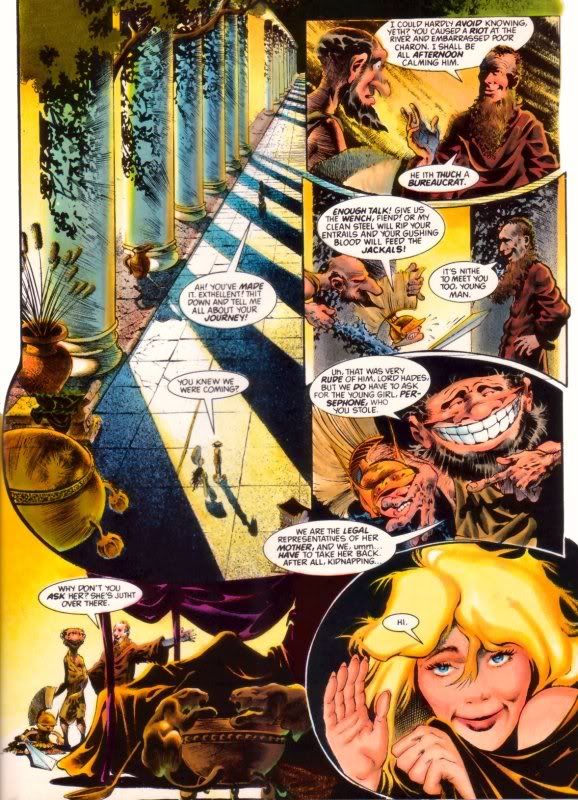 Epicurus proves his worth by solving the situation, in accordance with the myth. Volume 2 sees Epicurus with a small band of students (including women!!!) and still at odds with the other philosophers. He pokes a bit of fun with the Pythagoreans... 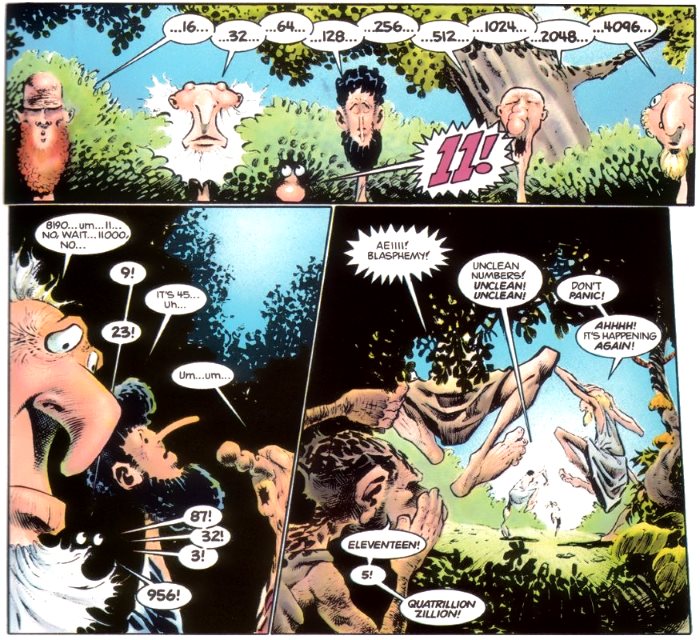 After that, the trio gets pulled into the problems of Zeus' lovers, and their kids. Quite frankly, Hera should have done a Lorena Bobbitt on the guy. Much silliness abound. The 2003 trade paperback includes these and a new story. The whole thing is brilliant an Loebs is in top form here, with both hilarious comedy, some real philosophy and logic, and some good old adventure and silliness. Sam Kieth's "bigfoot" cartooning style suits the material to a T and some of his images will have you rolling on the floor, like a giant three-headed bulldog guarding the gates of the Underworld! There's also a bit of a Calvin & Hobbes feel, as Alexander definitely shares a few traits with Calvin, while Epicurus is a voice of reason amid the insanity. By Zeus how I wish the creators would return to this material and tackle some more Greek myth; but, these were minor cult favorites, at best. Sigh...... The books aren't too hard to find and the trade is somewhat reasonable; the series is well worth it, especially if you are a Calvin & Hobbes fan, a Loebs and Kieth fan, or just enjoy a good laugh. |
|
|
|
Post by codystarbuck on Mar 6, 2017 23:36:20 GMT -5
While we are talking about Piranha Press, check out Gregory, by Marc Hempel.       These are less novels than short story collections. Gregory is a young boy, in an asylum, in a straightjacket, who says nothing but "I Gregory." Yeah, where do you thing Guardians of the Galaxy stole it from? (though I'm sure the gag predates Gregory). Gregory seems happy in his little world, though others think he should be treated and cured...   However, for Gregory, insanity works. The one "person" who seems to think Gregory is fine as he is and is his best friend is a rather vile rat, named Herman Vermin....  (from the Amazing Heroes Swimsuit Special 1990) The stories are wonderful satire, amazing surreal, hauntingly beautiful, and razor sharp. It's not exactly politically correct; but, that's half the fun! It has an Underground sensibility, and a bit of a gross out factor (mostly Herman, though Gregory has some sanitary issues); but, pokes gentle fun at a lot of social conventions. Hempel has used Gregory outside of the books, as seen in a recent post-election image... 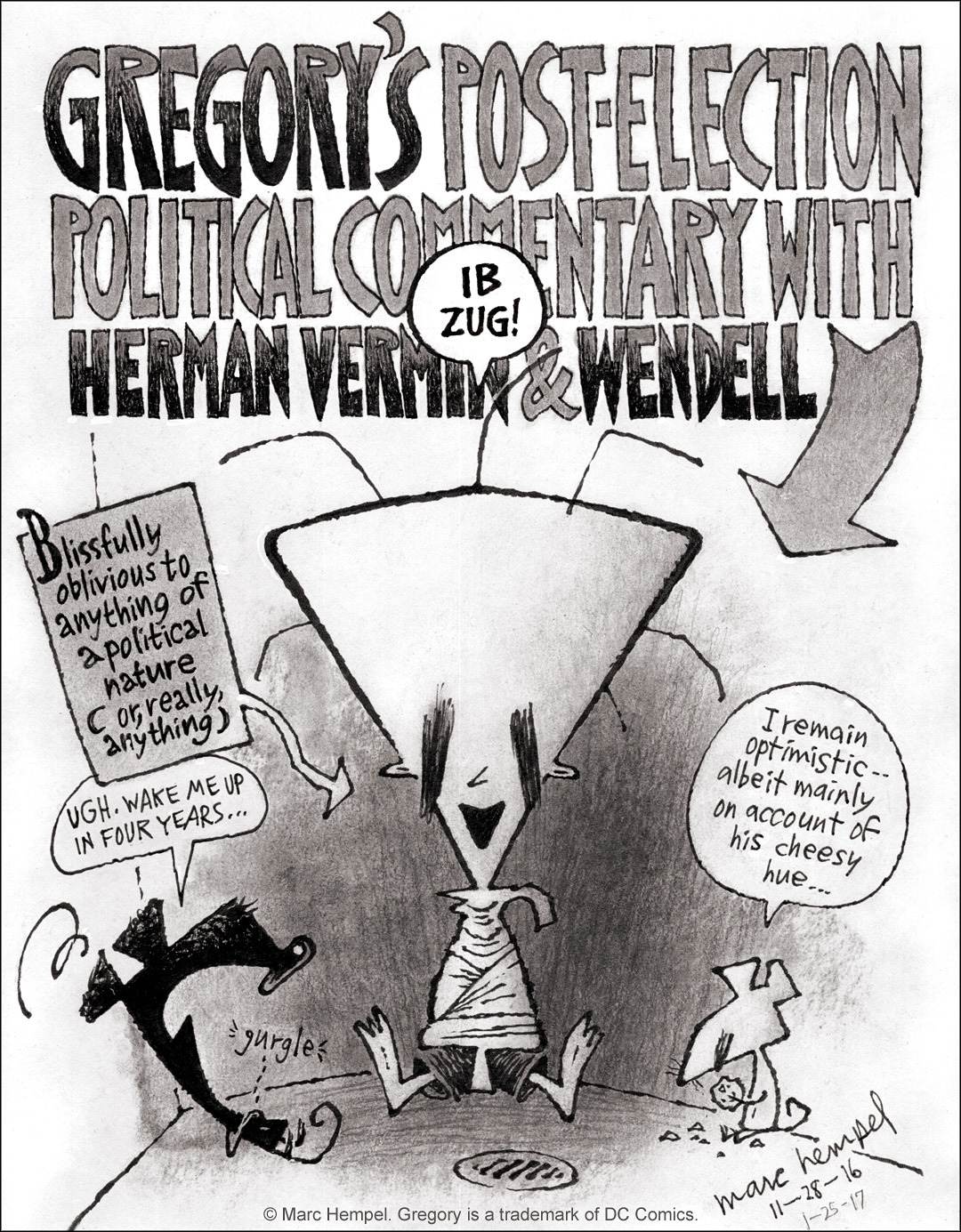 The original books were later collected into two trades. Either way, these are a fun read. Need another recommendation? let's ask the boy himself...  Couldn't have said it any better myself! |
|
|
|
Post by MDG on Mar 7, 2017 6:40:14 GMT -5
Want a fun graphic novel? Something with some action and adventure? A great warrior? A couple of hot chicks with ample bosoms? Some Greek philosophy? Wait, what? You had me right up to philosophy.Now, now, don't run away; this isn't some boring old college class. This is one man's revenge (well, two, actually) for those boring classes. I'm talking about..    EPICURUS, THE SAGE!!!!!!!!!!!!! I didn't know there was a collected edition--been looking for the second book for a while (looks like it's available through Amazon for <$10, shipped, in "Good" condition). Loebs told me at a convention that DC was obligated to publish the second book, but didn't want to, so the p;rint run was tiny: something like 5,000. It's a great book, though. Funny, and Keith's art is amazing. |
|
|
|
Post by wildfire2099 on Mar 7, 2017 7:41:00 GMT -5
I vaguely remember when that came out, but for some reason never got it.... definitely have to check it out at some point, I had totally forgotten it exists!
|
|
|
|
Post by codystarbuck on Mar 8, 2017 13:33:04 GMT -5
  This one is a bit more personal. From 1984-1988, I attended the University of Illinois, on a Naval ROTC scholarship. Aside from studying, I spent my time training to become a naval officer. I also refueled my love of comics, with regular access to an actual comic shop (a couple, in fact). During that time I came across Sam Glanzman's graphic novel memoir, A Sailor's Story, from the Marvel Graphic Novel line. I vaguely knew Glanzman's name from war comics and had seen one of his Hercules issues, at Charlton. At first glance, I thought it was a war comic, until I started reading. It's a war comic that is more than a war comic. Glanzman recounts his experiences, while serving onboard the USS Stevens. Those experiences had been used for stories before, at DC. Now, he told a longer form story with it. Before I go further, take this into account:the USS Stevens (DD-479) was launched in June 1942 and commissioned in Feb. 1943. She took part in the landings on the Gilbert Islands, the landings at Kwajalein, in the Marshalls, supported landings and convoy duty in the central Pacific, and took part in the actions in the philippines and the invasion of Borneo. Sam Glanzman served on the ship from 1941-1945; meaning, from the time it was being built to pretty much the end of the war. He saw a lot of action, to put it mildly. Glanzman gives us the war; but, it is never the central part of the story, which is why this is more than "just a war comic." Glanzman takes you through day-to-day life on a "tin can" (a destroyer). He reported aboard while the ship was in the Brooklyn Naval Yard and uses this scene to introduce the reader to naval jargon: the difference between a hatch and a door, a bulkhead and an overhead, what the head is, and a scuttlebut, what "turn to" means, what's a rack, and the job of a bos'n. Young Sam is taken through the ship by his new ship and given these lessons and so are we.  When the ship crosses the equator, Glanzman takes us inside a "shellback" initiation. The tradition holds that when the ship crosses the equator, it enters the Kingdom of Neptune, who is a little ticked off. Those who have crossed before have been initiated as "shellbacks;" those who haven't ae lowly "polliwogs." To appease Neptune and the Royal Court, the polliwogs are put through the initiation. Essentially, it's a big hazing ritual. In my day, you crawled around on the ship, on your hands and knees and crawled through a tunnel of slime (garbage, food, and anything noxious they can find, without actually poisoning anyone). You are fed a breakfast of crap (food laced with gross condiments and additives), made to do some exercises (in some cases), pull a rubber marital aid out of a toilet basin with your teeth, and kiss the feet of the Royal Court and have year face jammed into the crud-smeared belly of the Royal Baby. Then, you are "dunked in the ocean" (a water tank) and are reborn a shellback. In Glanzman's day you ran a gauntlet of men armed with sections of rubber firehose, who beat you. There was a crackdown in my era, after a sailor died from a ruptured stomach, after being forced to do extended sit-ups. When we crossed, one sailor was chased (as they rounded up the polliwogs) and ran into the edge of a door (which has metal surfaces which the "dogs" latch onto), opening a gash in his forehead that had to be stitched up by the corpsman. Back then, I thought it was juvenile and vicious and little has changed that perception and Glanzman's time was far tougher than mine. Glanzman doesn't shirk the action, though. His ship carried an experimental float plane that was launched with a catapult, that swung out from the ship. It proved to be ineffective and was removed; but, Glanzman provides some insight into it.  Glanzman gives us the war, in detail; but never glory... 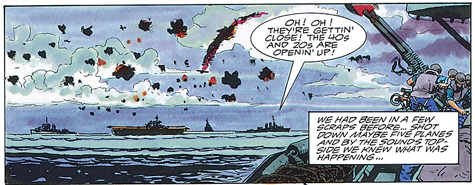 He also gives us the quiet beauty of the sea... 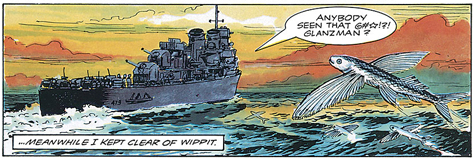 Through it all, it is the quiet detail and perception that strikes you the most. Sam is like an old uncle relating war stories; but never making it sound like he's bragging. He was one of many doing a job that needed done, which is a common attitude of the WW2 veterans. My Uncle (who served in the Army, in the 50s), my brother and I (who served in the late 80s and 90s) talked about this not long ago. My uncle served with WW2 combat veterans, who rarely spoke about what they did and saw, other than to pass on skills and experience to a new generation. Glanzman exudes that same attitude in his narrative. This is a "true" war comic; it was Sam's life for 4 of the most turbulent years in human history. It shaped the work he did in comics, as much as his personal life. Even if you are not a war comic fan, this is a book to read. It gives you a real first-hand sense of what WW2 was like and the generation who fought it. It has moments of beauty and poetry, and horror, and the mundane tasks of everyday life. It has been repackaged in an excellent edition by Dover Books, who also reprinted his USS Stevens stories.   Fair winds and following seas, Mr Glanzman.    |
|
|
|
Post by codystarbuck on Mar 8, 2017 18:39:57 GMT -5
Writing about Quantum leap, at Innovation, brought to my mind another great graphic novel...    I first encountered Howard Cruse in the original incarnation of Comic Scene magazine. I'm sure many of you remember the comic-oriented magazine, from Starlog Press, though probably more for the second run, which had a heavier media focus (meaning Hollywood). The original run was more like a fanzine with a bigger budget and Cruse had a regular column in the magazine. I stumbled across some of the old issues and ate them up and hunted down the rest. I enjoyed Cruse's column, but had never seen his work, Barefootz and Wendell.     It would be much later that I would encounter a Wendel collection, while working for Barnes & Noble. However, when Stuck Rubber Baby was solicited, I was in the US Navy and had broadened my horizons into the independent and alternative comics world. I knew Cruse's name and ordered it, sight unseen. Cruse came from the Undergrounds and his stories focused on an analogue of himself, a young gay man. Stuck Rubber Baby focuses another analogue; but one based on Cruse's experiences growing up in segregated Alabama, as the son of a Baptist preacher. Cruse mixes in events of the civil rights movement with a gay man's coming of age. The end result is fascinating, as it is a window into two different, yet similar experiences in the country's history. We see things like the 16th Street baptist Church bombing and the murder of Emmett Till, as well as racism within the very closeted gay community. Cruse's protagonist finds himself with his draft notice and Cruse humorously illustrates his induction...  However, reality often arises after the humor, as he relates people who ended or were treated horribly. It's a gentle, humorous and poignant piece of work. The art is fantastic, as Cruse makes great use of the black & white medium, using several pencil and inking techniques to lend texture to the work. The book was originally conceived under DC's Piranha Press, though it took longer to create, so it was published under the Paradox Press name (used for the Big Book of...series). It was later reprinted in 2010, under the Vertigo banner, with a new introduction from Alison Bechdel (Dykes to Watch Out For, Fun Home, Are You My Mother?) The original won the Eisner and harvey Awards for Best Graphic Novel and was nominated for the American Library Association's Lesbian and Gay Award and the Lambda Literary Award. Some weren't happy with it, as in 2004, a Texas citizen's group demanded it be removed from the young adult section of the local library, along with 118 other works. Heaven forbid anyone be exposed to a gentle work that speaks of tolerance and according human beings the same dignity and rights! |
|
|
|
Post by codystarbuck on Mar 8, 2017 19:29:24 GMT -5
   This is a slightly different coming of age, of a young man named Jonas Fink (called Finkel, in the NBM translation, of vol. 1), as created by Italian writer/artist Vittorio Giardino. Jonas Fink is a young Czech, living in Prague, under Communist rule. One day his father is taken away by security men. His mother frantically tries to find out why and secure his release. The family soon finds they are without friends. Jonas is ostracized at school and the parents of his best friend won't let their son be seen with him anymore. He is attacked by bullies and despite being the best student, is denied application to university. The family falls on hard times and sell their meager possessions, while Jonas' mother teaches French to earn some money. Jonas gets a job as a delivery boy, for a seamstress. The mother is warned off of further inquiries into her husband's fate, at the risk of her own freedom. Jonas finds himself fired after a woman who has been teasing him, by undressing in front of him to try on dresses, pushes him to respond in kind, until her husband walks in and catches them. Their family disappeared during the war and all they have is each other. Jonas eventually gains employment as an apprentice laborer, then apprentice plumber. Eventually he finds employment in a bookstore and love, with a young woman, mixed in with a dissident literary group. Through it all we see the corrupt system, how the family is kept ignorant of the father's fate, only being informed 2 years after the fact he was sentenced to 10 years, without communication. Jonas is an outcast as the son of a "traitor" and further as a Jew. Yet, he still struggles to find his place in the world. Giardino is a subtle artist and his linework is very gentle, filled with detail that sort of creeps in on you, rather than hits you in the face, like a George Perez. He draws people with real bodies and real faces; faces with character. The woman who tries to seduce Jonas is hardly a great beauty or a Mrs. Robinson physically. She's a mature woman with a mature woman's body. The book is filled with life and life is conversation. You won't find wall to wall action, though things happen. What you will find is literature and history, and artistic mastery. Prague is noted for its beauty and Giardino captures that, as well as the beauty and ugliness of humanity. There are doses of humor, arising from character moments, as well as a gentle poetry to many scenes. However, if it is action you want, try Giardino's Max Friedman stories...      Max Friedman is a seemingly ordinary man, living an ordinary life, as a businessman in Switzerland. He has a daughter he adores. He also has a past, in the somewhat murky world of international intelligence, in France. It is this past that brings him back into the world of shadows and intrigue, which takes him from Budapest (Hungarian Rhapsody), to Istanbul (Orient Gateway) to Spain (No Pasaran!). Along the way, we learn that this unassuming Jewish businessman is a resourceful and smart agent. Make no mistake, this isn't James Bond. It has far more in common with Graham Greene, who is quoted in the Catalan Communications edition of Hungarian Rhapsody. It features a lot of running from armed men, hiding in shadowy doorways, escaping in speeding cars, conferences in cafes and bars, and a trip through an exotic world. No Pasaran takes Max back to Spain, during the Civil War, after he left the futile cause. He is back to find a friend, as a favor to the friend's wife. The Friedman stories were reprinted by Catalan Communications, in the late 80s and NBM in the 90s and 2000s; but, are out of print, in English. The work is seriously calling for a new collection, as is all of Giardino's work, including his detective character Sam Pezzo. The Max Friedman stories would make fantastic movies or tv series, in the line of John Le Carre's work. If you want something a little saucier, try Giardino's Little Ego...  The work appeared in Glamour International and was reprinted in Heavy Metal and Penthouse, as well as in collected form from NBM and Heavy Metal. It features an erotic parody of Little Nemo in Slumberland, with a female protagonist and her erotic dream, done in the same single page format that Nemo had. They are delightfully funny and gently erotic, playful rather than graphic. Giardino's art is as gorgeous as his heroine. It's an adult work, without falling into the chasm of just being porn. It has a joyful spirit that never exploits or titillates; just amuses and delights. |
|
|
|
Post by codystarbuck on Mar 9, 2017 23:42:59 GMT -5
       The Cities of the Fantastic. Now these are great graphic novels! This series is from artist Francois Schuiten and writer Benoit Peeters. Schuiten is the son of two Belgian architects (both mother and father). Bear that in mind, as architecture plays a major role in his stories. While in school, he met Claude Renard, who headed the comics department of the Saint-Luc Institute. Schuiten and Renard worked together creating stories, and Francois' brother Luc also became involved. Some of these earlier stories were collected in the Humanoids/DC Comics collection, The Hollow Grounds. More on that, later. He soon began working with friend Benoit Peeters on the magazine A Suivre, where the Cities of the Fantastic debuted. All of the works feature a great emphasis on architecture and the society living within it; but, they aren't just cityscapes. Humanity is a major focus throughout and the stories have a dreamlike nature, that mixes in influences from things like Little Nemo in Slumberland, Metropolis, Franz Kafka, The Prisoner and stories of fantastic places and things. Architecture isn't his sole love, as transportation is often a major element, books and libraries, and romance. The Great Walls of Samaris finds a traveller who comes to a new city of beautiful and immense buildings, mostly done in a dreamy art nouveau style (which is a major feature of Brussels architecture). He has been sent from another city to report on the place, adding a layer of mystery. The journey (aboard a fantastic flying craft) takes some time and he then finds himself within the odd city, with people staring at him. He soon finds repetition in the sights and an artifice to things, with doorways blocked off. The mystery deepens and Schuiten and Peeters leave many things ambiguous. It's a feast for the eyes and the brain.    Fever in Urbicand showcases Robick, an Urbatect (an architect who designs whole cities), who lives in a city full of imposing art deco buildings, with a rather fascist veneer. His pet project of building a bridge across a rive to bring better symmetry to the city has been thwarted by the ruling council; but, an intriguing find at a building site has his interest. A small cube, composed of interlocking struts (but with open sides, like the skeleton of a cube), that seems to exist for no reason. He experiments on it and finds it is impervious to damage. then, he notices the struts seem to be growing, at the joints. These "sprouts" continue to grow until a new cube segment if formed. This growth continues along geometric lines. Nothing seems to inhibit it. At one point, Robick falls asleep at his desk and the struts grow into his arm, though he feels no pain. Eventually it grows to a size that is beyond his body, freeing him. Soon, the structure is so large it is enveloping the city, creating new bridges across the river, joining both sides. Meeting places spring up at junctures, some offering elicit entertainment. Societal order starts breaking down and the rulers try to put a stop to it. New structures are added to the foundation of the network; but eventually collapse. The network continues to grow until it is beyond sight, leaving behind a broken society. In the end, we see Robick trying to sculpt a new cube. 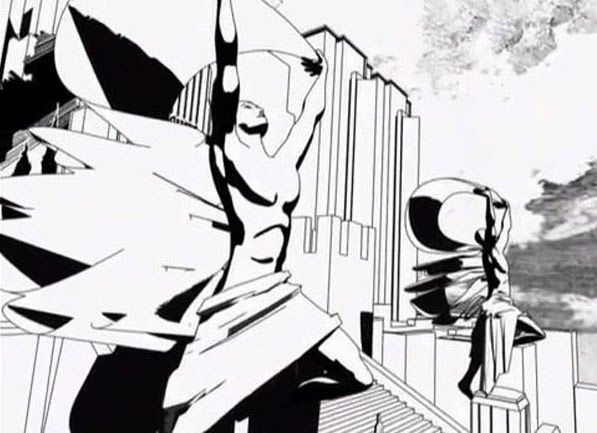 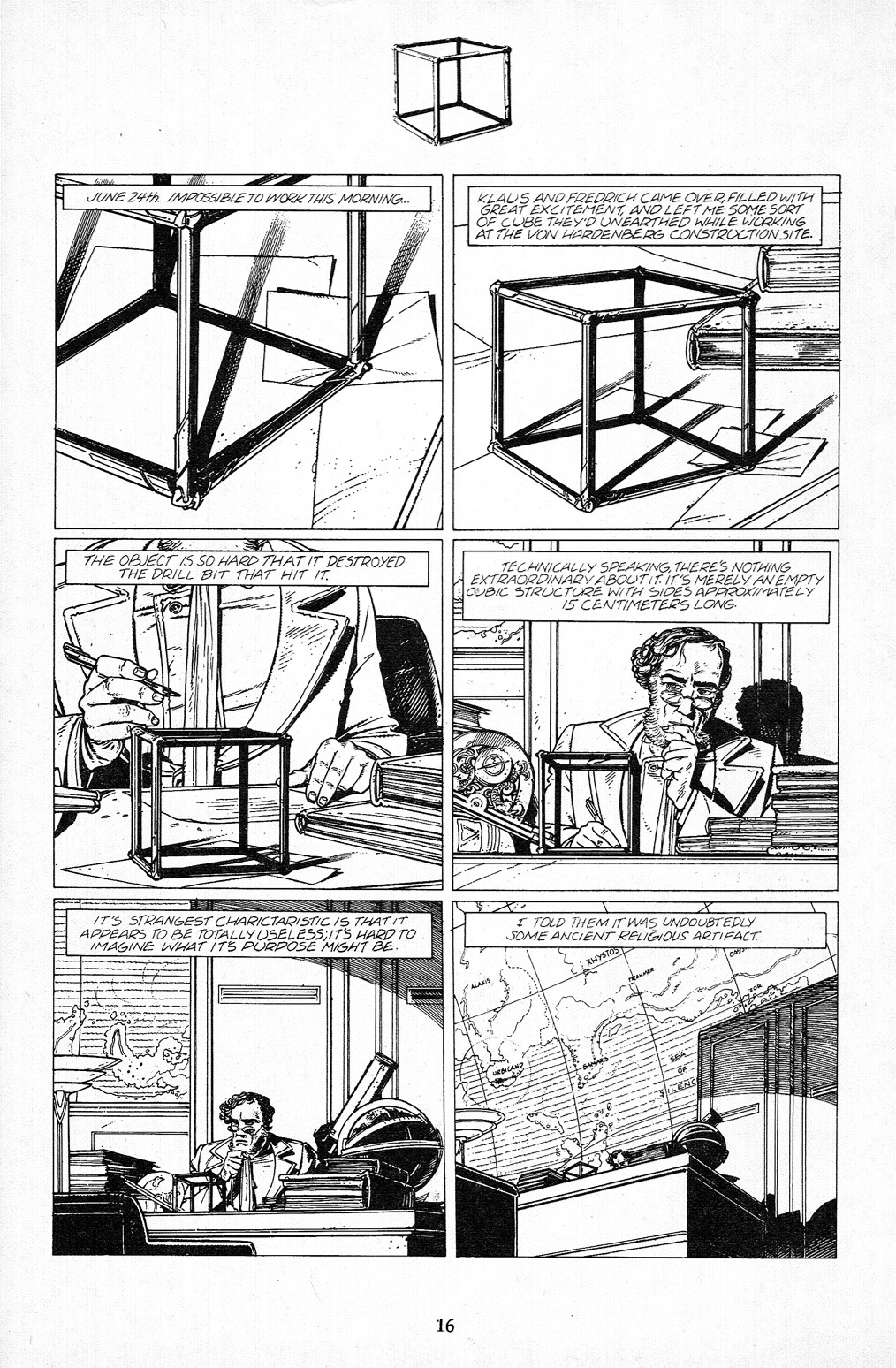  The Tower sees a caretaker of an upper level of an immense tower busy at his work, restoring crumbling sections, within his zone. He's having trouble maintaining his area and lacks resources and manpower (he's alone). He decides to take a journey to the lower levels to speak to the authorities. Along the way, he encounters no one. Has the Tower been abandoned? This one is a little lower on the scale of enjoyment for me, though the artwork is beautiful. The tower itself seems like the Tower of babel, made real. 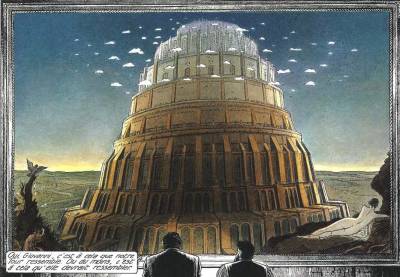 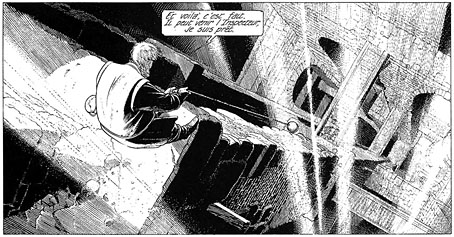 Brusel features a florist who finds himself caught up in schemes to remold the city and those who oppose the schemes. it draws upon some of the architectural history of Brussels, where architectural changes often came with massive social upheaval and conflict. A trip through a model of the city provides breathtaking imagery... 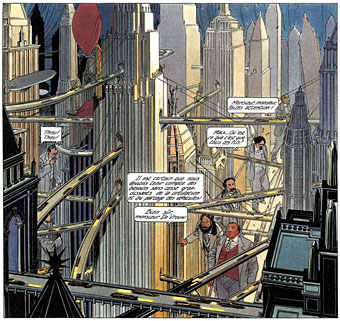  The Invisible Frontier features a cartographer who is drawn into the plans of the ruler of his country, to redraw its borders. Along the way, he sees how the changing of maps is the changing of history, and he also meets a mysterious woman with a map tattooed on her torso, that tells a story different from official charts. Much of this was commentary on the breakup of of the former Yugoslavia.  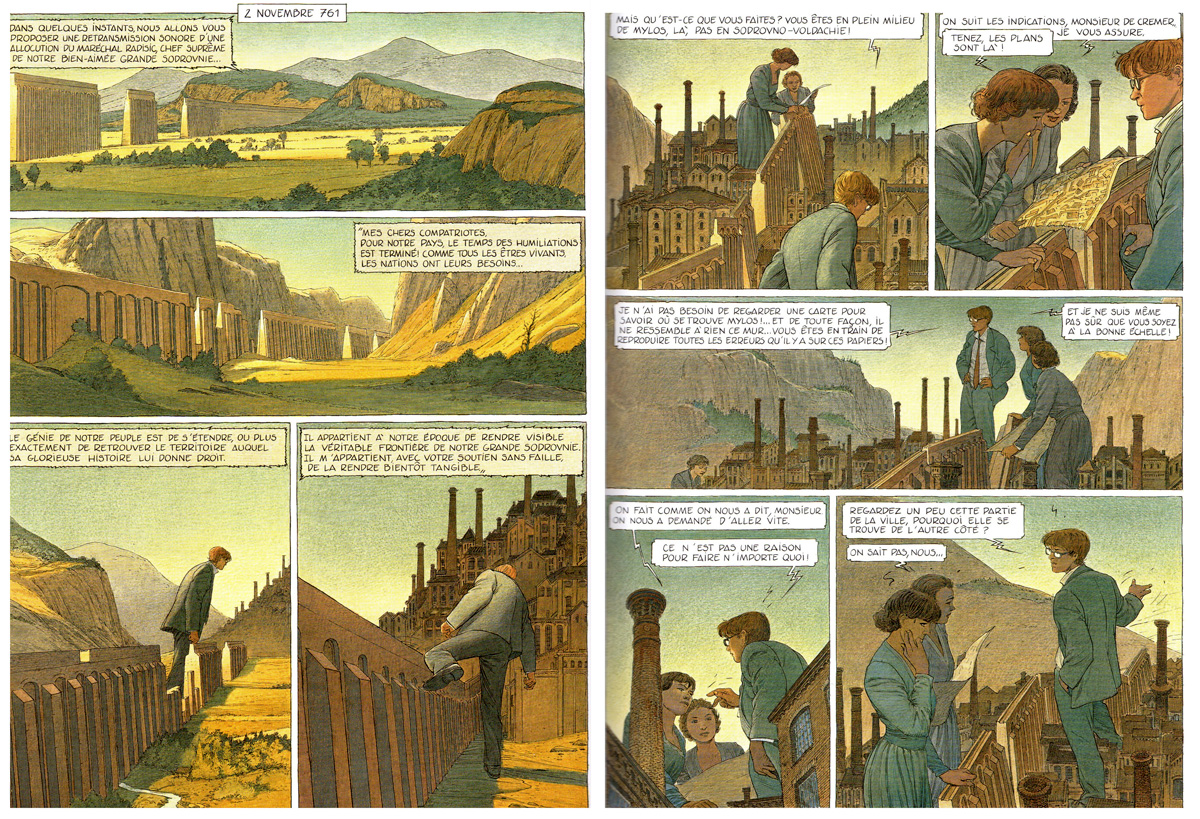 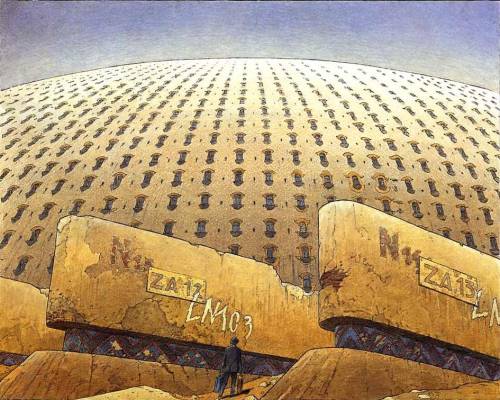 As you can see from the details, some of these works are greater favorites, for me, than others, though I love all of them. Schuiten draws with immense beauty and fills his world with a dream-like facade. It's fantasy of the best kind. Mixed with that is a love of fantastic transportation, with monorails, airships, trains, ships, and other vessels of travel to exotic lands. His is the world of adventure and discovery that thrilled imaginations over time, with tales of great cities and cultures. Schuiten and Peeters tap into these fascinations and whisk us to new ones, in an era where we can see the entire globe, via a monitor. Authority is often questioned and there is a romantic soul at the heart of all of the stories. The architecture is as much a character, as it is a setting. Now, the sad part; the English editions are out of print and some are pretty pricey, though not all. NBM published English editions, up through Invisible Frontier and The Tower and Fever in Urbicand were serialized in Dark Horse Comics' Cheval Noir (starting with the first issue). Heavy Metal also published The Tower and a couple of early stories, from Renard and Schuiten. NBM also published The Book of Schuiten, featuring art from Schuiten's work, including some from outside his comics material. Schuiten has designed metro stations in Brussels, sets for the movie Gwendoline (aka The Perils of Gwendoline in the Land of Yik-Yak) and The Golden Compass, and has even designed stamps. Artistically he draws upon the work of Magritte, Escher, Dore and architects Victor Horta and Etienne-Louis Boullee. As you can see, Schuiten is an artist who crosses boundaries between narrative art, architecture, fine art, advertising, and filmmaking. Much like the cube of Fever, he builds bridges between the art worlds.  |
|
|
|
Post by Deleted on Mar 9, 2017 23:46:09 GMT -5
|
|
|
|
Post by codystarbuck on Mar 10, 2017 0:18:08 GMT -5
Another favorite from Europe, though he now lives in the US: Pepe Moreno.     Moreno is a Spanish artist who started out working for L'Echo des Savanes and Metal Hurlant, in Europe, and for Warren (Eerie and Vampirella) in the US. As time went on, hos work was featured in Heavy Metal, which serialized some of the stories that appear in Zeppelin, and featured his graphic novel Rebel. Generation Zero was one of the last stories serialized in Epic Illustrated and was written by editor Archie Goodwin, who helped bring Moreno to Batman. Zeppelin features several short pieces from Moreno, often dealing with war and conflict. The central piece features a story that seems to riff on The Final Countdown, as a naval fighter aircraft launches and finds itself enveloped inside a massive alien craft, only to emerge in another time and get caught up in a piece of history...  Moving on from short pieces, Moreno developed a novel, featuring the adventures of a hero named Rebel. Rebel and his friends live in a post-apocalyptic New York, where life is anything but safe. 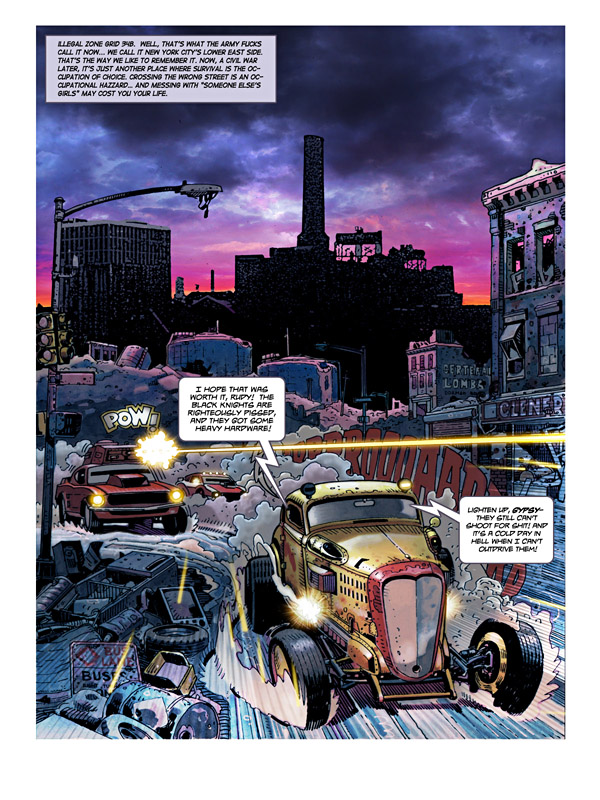 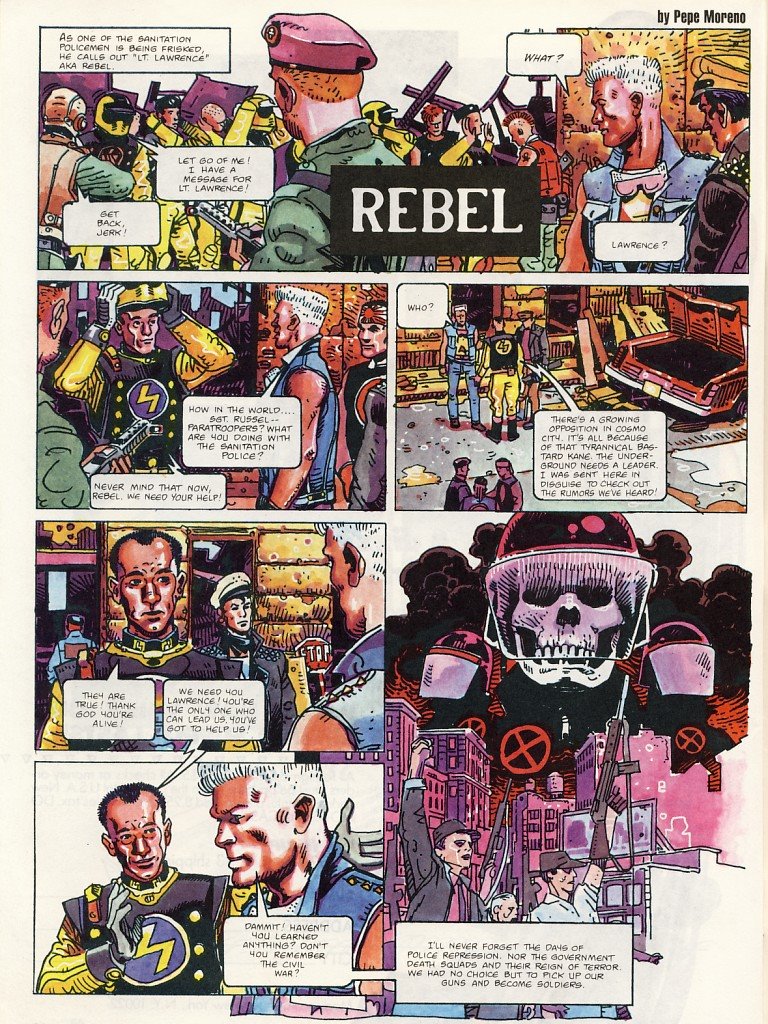 Rebel and his fellow gang members are often in conflict with other gangs, and the fascist Sanitation Police. If Zeppelin invokes The Final Countdown, this is a cross between Mad Max and Death race 2000. Generation Zero is probably Moreno's most mature work and I think it is his creative peak. It features a somewhat rebellious group of young men, living in a fortified underground city, known as Sanctuary. This group is sent off to make contact with the outside world, in an advanced multi-purpose vessel. There is also the chance that the leader may find out what happened to his father. Along the journey, he runs into mutants, zombies, a fascist army, and clues to his father's fate. In the end, he brings war to Sanctuary's doorstep. There's some really great stuff in here and much stornger characters than Moreno's previous efforts. Goodwin is a master of pulp storytelling and this fits the bill. 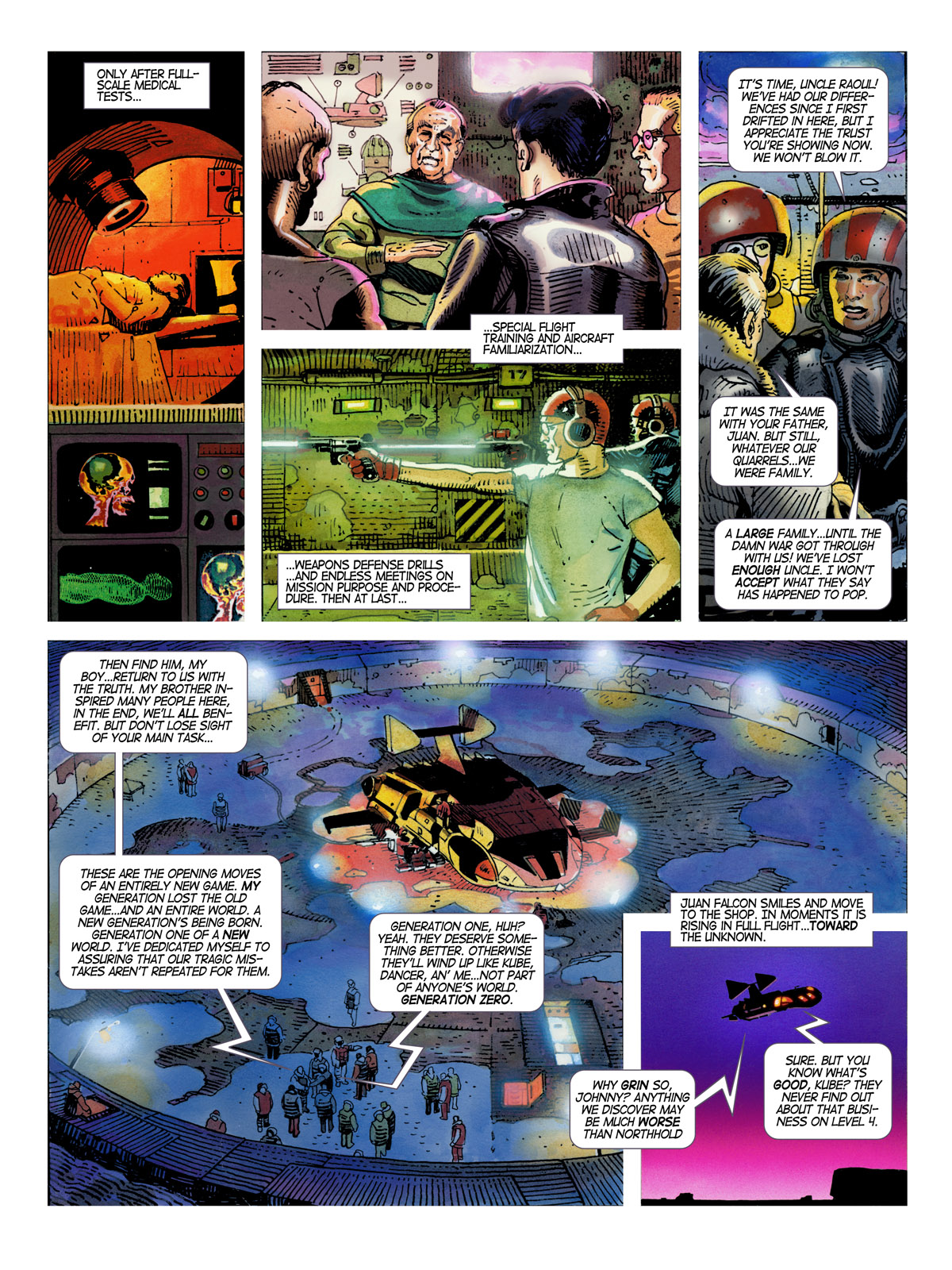 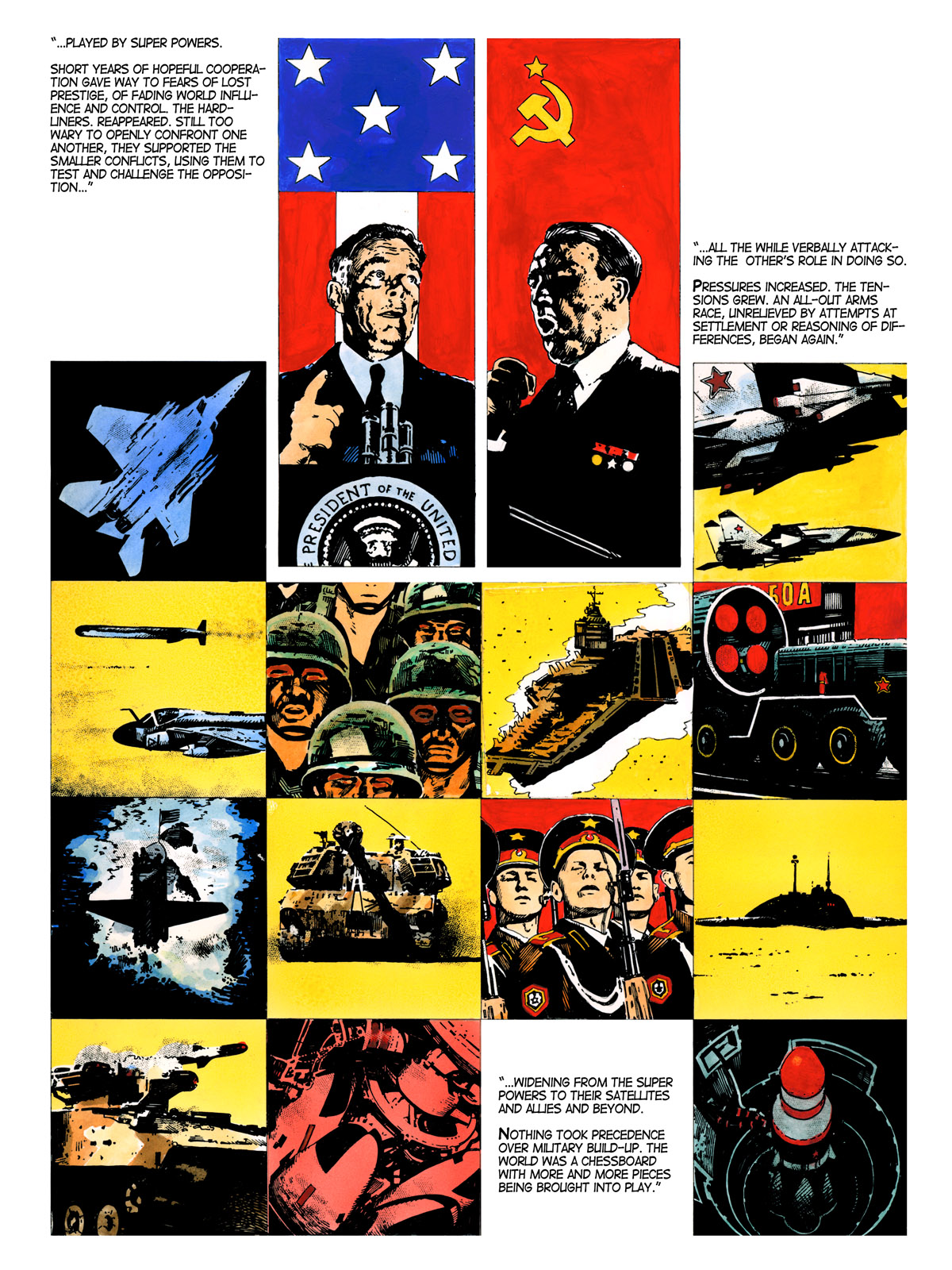  Batman: Digital Justice was another early experiment in computer-generated art, along with Mike saenz' Shatter and iron Man: Crash. Moreno used an Amiga computer to design the work, with more advanced visuals than Saenz' work, though the narrative is a bit lacking. The images seem dated today, much like the CGI of Tron; but, at the time, it was groundbreaking. A new Batman has arisen in the future and he soon finds a new Robin. The joker has left behind a deadly virus, The Joker Virus, that is disrupting the city. It is up to the new Batman and his Bat-Computer to stop the chaos. Some samples...  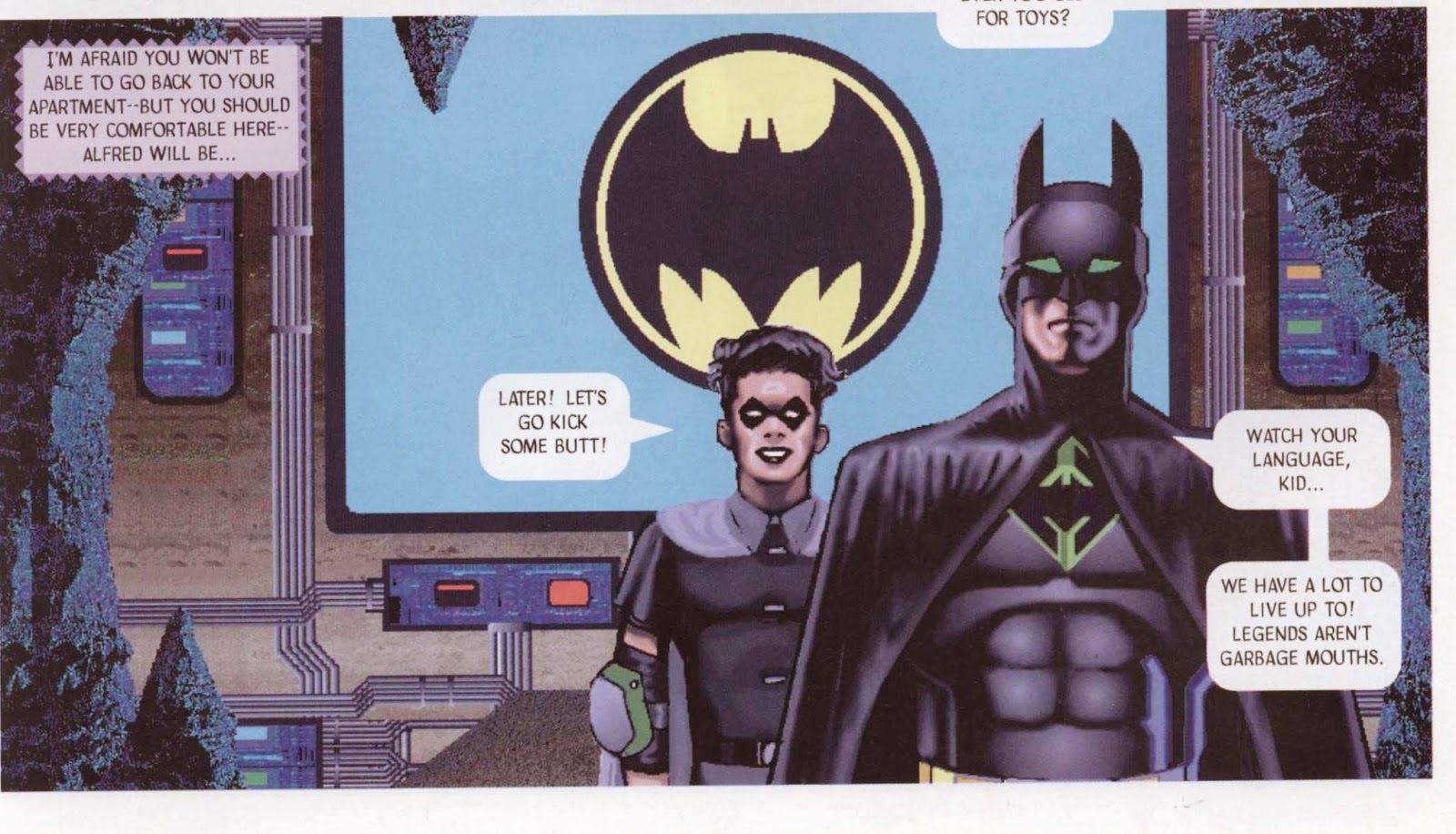 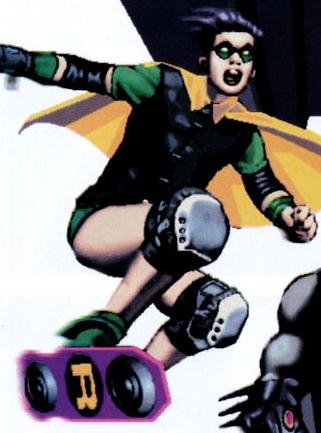 Batman gets a new Batmobile, which seems to have influenced Batman Beyond... 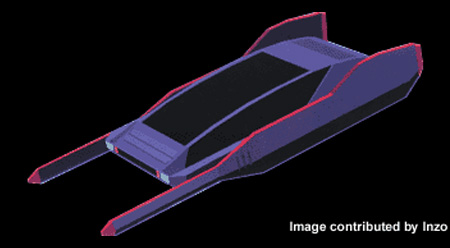 This is Moreno's best known work, due to the high profile of the character; but, I find it to be the least satisfying. It seems more like a great concept than a great story. Moreno went off to work in computer game design, developing the BeachHead games, with his company Digital Fusion. |
|
|
|
Post by Deleted on Mar 10, 2017 0:30:42 GMT -5
Thanks for recommending these. I put them on my wish list. |
|
shaxper
CCF Site Custodian
Posts: 22,865
|
Post by shaxper on Mar 10, 2017 7:29:37 GMT -5
       The Cities of the Fantastic. Now these are great graphic novels! This series is from artist Francois Schuiten and writer Benoit Peeters. Schuiten is the son of two Belgian architects (both mother and father). Bear that in mind, as architecture plays a major role in his stories. While in school, he met Claude Renard, who headed the comics department of the Saint-Luc Institute. Schuiten and Renard worked together creating stories, and Francois' brother Luc also became involved. Some of these earlier stories were collected in the Humanoids/DC Comics collection, The Hollow Grounds. More on that, later. He soon began working with friend Benoit Peeters on the magazine A Suivre, where the Cities of the Fantastic debuted. All of the works feature a great emphasis on architecture and the society living within it; but, they aren't just cityscapes. Humanity is a major focus throughout and the stories have a dreamlike nature, that mixes in influences from things like Little Nemo in Slumberland, Metropolis, Franz Kafka, The Prisoner and stories of fantastic places and things. Architecture isn't his sole love, as transportation is often a major element, books and libraries, and romance. The Great Walls of Samaris finds a traveller who comes to a new city of beautiful and immense buildings, mostly done in a dreamy art nouveau style (which is a major feature of Brussels architecture). He has been sent from another city to report on the place, adding a layer of mystery. The journey (aboard a fantastic flying craft) takes some time and he then finds himself within the odd city, with people staring at him. He soon finds repetition in the sights and an artifice to things, with doorways blocked off. The mystery deepens and Schuiten and Peeters leave many things ambiguous. It's a feast for the eyes and the brain.    Fever in Urbicand showcases Robick, an Urbatect (an architect who designs whole cities), who lives in a city full of imposing art deco buildings, with a rather fascist veneer. His pet project of building a bridge across a rive to bring better symmetry to the city has been thwarted by the ruling council; but, an intriguing find at a building site has his interest. A small cube, composed of interlocking struts (but with open sides, like the skeleton of a cube), that seems to exist for no reason. He experiments on it and finds it is impervious to damage. then, he notices the struts seem to be growing, at the joints. These "sprouts" continue to grow until a new cube segment if formed. This growth continues along geometric lines. Nothing seems to inhibit it. At one point, Robick falls asleep at his desk and the struts grow into his arm, though he feels no pain. Eventually it grows to a size that is beyond his body, freeing him. Soon, the structure is so large it is enveloping the city, creating new bridges across the river, joining both sides. Meeting places spring up at junctures, some offering elicit entertainment. Societal order starts breaking down and the rulers try to put a stop to it. New structures are added to the foundation of the network; but eventually collapse. The network continues to grow until it is beyond sight, leaving behind a broken society. In the end, we see Robick trying to sculpt a new cube.    The Tower sees a caretaker of an upper level of an immense tower busy at his work, restoring crumbling sections, within his zone. He's having trouble maintaining his area and lacks resources and manpower (he's alone). He decides to take a journey to the lower levels to speak to the authorities. Along the way, he encounters no one. Has the Tower been abandoned? This one is a little lower on the scale of enjoyment for me, though the artwork is beautiful. The tower itself seems like the Tower of babel, made real.   Brusel features a florist who finds himself caught up in schemes to remold the city and those who oppose the schemes. it draws upon some of the architectural history of Brussels, where architectural changes often came with massive social upheaval and conflict. A trip through a model of the city provides breathtaking imagery...   The Invisible Frontier features a cartographer who is drawn into the plans of the ruler of his country, to redraw its borders. Along the way, he sees how the changing of maps is the changing of history, and he also meets a mysterious woman with a map tattooed on her torso, that tells a story different from official charts. Much of this was commentary on the breakup of of the former Yugoslavia.    As you can see from the details, some of these works are greater favorites, for me, than others, though I love all of them. Schuiten draws with immense beauty and fills his world with a dream-like facade. It's fantasy of the best kind. Mixed with that is a love of fantastic transportation, with monorails, airships, trains, ships, and other vessels of travel to exotic lands. His is the world of adventure and discovery that thrilled imaginations over time, with tales of great cities and cultures. Schuiten and Peeters tap into these fascinations and whisk us to new ones, in an era where we can see the entire globe, via a monitor. Authority is often questioned and there is a romantic soul at the heart of all of the stories. The architecture is as much a character, as it is a setting. Now, the sad part; the English editions are out of print and some are pretty pricey, though not all. NBM published English editions, up through Invisible Frontier and The Tower and Fever in Urbicand were serialized in Dark Horse Comics' Cheval Noir (starting with the first issue). Heavy Metal also published The Tower and a couple of early stories, from Renard and Schuiten. NBM also published The Book of Schuiten, featuring art from Schuiten's work, including some from outside his comics material. Schuiten has designed metro stations in Brussels, sets for the movie Gwendoline (aka The Perils of Gwendoline in the Land of Yik-Yak) and The Golden Compass, and has even designed stamps. Artistically he draws upon the work of Magritte, Escher, Dore and architects Victor Horta and Etienne-Louis Boullee. As you can see, Schuiten is an artist who crosses boundaries between narrative art, architecture, fine art, advertising, and filmmaking. Much like the cube of Fever, he builds bridges between the art worlds.  This looks AMAZING. Considering purchasing them for the artwork alone, even if I can't understand the words being spoken. |
|
|
|
Post by codystarbuck on Mar 10, 2017 10:31:40 GMT -5
       The Cities of the Fantastic. Now these are great graphic novels! This series is from artist Francois Schuiten and writer Benoit Peeters. Schuiten is the son of two Belgian architects (both mother and father). Bear that in mind, as architecture plays a major role in his stories. While in school, he met Claude Renard, who headed the comics department of the Saint-Luc Institute. Schuiten and Renard worked together creating stories, and Francois' brother Luc also became involved. Some of these earlier stories were collected in the Humanoids/DC Comics collection, The Hollow Grounds. More on that, later. He soon began working with friend Benoit Peeters on the magazine A Suivre, where the Cities of the Fantastic debuted. All of the works feature a great emphasis on architecture and the society living within it; but, they aren't just cityscapes. Humanity is a major focus throughout and the stories have a dreamlike nature, that mixes in influences from things like Little Nemo in Slumberland, Metropolis, Franz Kafka, The Prisoner and stories of fantastic places and things. Architecture isn't his sole love, as transportation is often a major element, books and libraries, and romance. The Great Walls of Samaris finds a traveller who comes to a new city of beautiful and immense buildings, mostly done in a dreamy art nouveau style (which is a major feature of Brussels architecture). He has been sent from another city to report on the place, adding a layer of mystery. The journey (aboard a fantastic flying craft) takes some time and he then finds himself within the odd city, with people staring at him. He soon finds repetition in the sights and an artifice to things, with doorways blocked off. The mystery deepens and Schuiten and Peeters leave many things ambiguous. It's a feast for the eyes and the brain.    Fever in Urbicand showcases Robick, an Urbatect (an architect who designs whole cities), who lives in a city full of imposing art deco buildings, with a rather fascist veneer. His pet project of building a bridge across a rive to bring better symmetry to the city has been thwarted by the ruling council; but, an intriguing find at a building site has his interest. A small cube, composed of interlocking struts (but with open sides, like the skeleton of a cube), that seems to exist for no reason. He experiments on it and finds it is impervious to damage. then, he notices the struts seem to be growing, at the joints. These "sprouts" continue to grow until a new cube segment if formed. This growth continues along geometric lines. Nothing seems to inhibit it. At one point, Robick falls asleep at his desk and the struts grow into his arm, though he feels no pain. Eventually it grows to a size that is beyond his body, freeing him. Soon, the structure is so large it is enveloping the city, creating new bridges across the river, joining both sides. Meeting places spring up at junctures, some offering elicit entertainment. Societal order starts breaking down and the rulers try to put a stop to it. New structures are added to the foundation of the network; but eventually collapse. The network continues to grow until it is beyond sight, leaving behind a broken society. In the end, we see Robick trying to sculpt a new cube.    The Tower sees a caretaker of an upper level of an immense tower busy at his work, restoring crumbling sections, within his zone. He's having trouble maintaining his area and lacks resources and manpower (he's alone). He decides to take a journey to the lower levels to speak to the authorities. Along the way, he encounters no one. Has the Tower been abandoned? This one is a little lower on the scale of enjoyment for me, though the artwork is beautiful. The tower itself seems like the Tower of babel, made real.   Brusel features a florist who finds himself caught up in schemes to remold the city and those who oppose the schemes. it draws upon some of the architectural history of Brussels, where architectural changes often came with massive social upheaval and conflict. A trip through a model of the city provides breathtaking imagery...   The Invisible Frontier features a cartographer who is drawn into the plans of the ruler of his country, to redraw its borders. Along the way, he sees how the changing of maps is the changing of history, and he also meets a mysterious woman with a map tattooed on her torso, that tells a story different from official charts. Much of this was commentary on the breakup of of the former Yugoslavia.    As you can see from the details, some of these works are greater favorites, for me, than others, though I love all of them. Schuiten draws with immense beauty and fills his world with a dream-like facade. It's fantasy of the best kind. Mixed with that is a love of fantastic transportation, with monorails, airships, trains, ships, and other vessels of travel to exotic lands. His is the world of adventure and discovery that thrilled imaginations over time, with tales of great cities and cultures. Schuiten and Peeters tap into these fascinations and whisk us to new ones, in an era where we can see the entire globe, via a monitor. Authority is often questioned and there is a romantic soul at the heart of all of the stories. The architecture is as much a character, as it is a setting. Now, the sad part; the English editions are out of print and some are pretty pricey, though not all. NBM published English editions, up through Invisible Frontier and The Tower and Fever in Urbicand were serialized in Dark Horse Comics' Cheval Noir (starting with the first issue). Heavy Metal also published The Tower and a couple of early stories, from Renard and Schuiten. NBM also published The Book of Schuiten, featuring art from Schuiten's work, including some from outside his comics material. Schuiten has designed metro stations in Brussels, sets for the movie Gwendoline (aka The Perils of Gwendoline in the Land of Yik-Yak) and The Golden Compass, and has even designed stamps. Artistically he draws upon the work of Magritte, Escher, Dore and architects Victor Horta and Etienne-Louis Boullee. As you can see, Schuiten is an artist who crosses boundaries between narrative art, architecture, fine art, advertising, and filmmaking. Much like the cube of Fever, he builds bridges between the art worlds.  This looks AMAZING. Considering purchasing them for the artwork alone, even if I can't understand the words being spoken. If you look around a bit, you can find some of them for a decent price. Others you can get in French and Spanish, for a decent price. The Book of Schuiten is an art collection, no stories (though some excerpts); so, it's a great one to target, if you are curious. It looks like IDW is bringing them back, with Theory of a Grain of Sand available now and Samaris scheduled for June. |
|


























































































